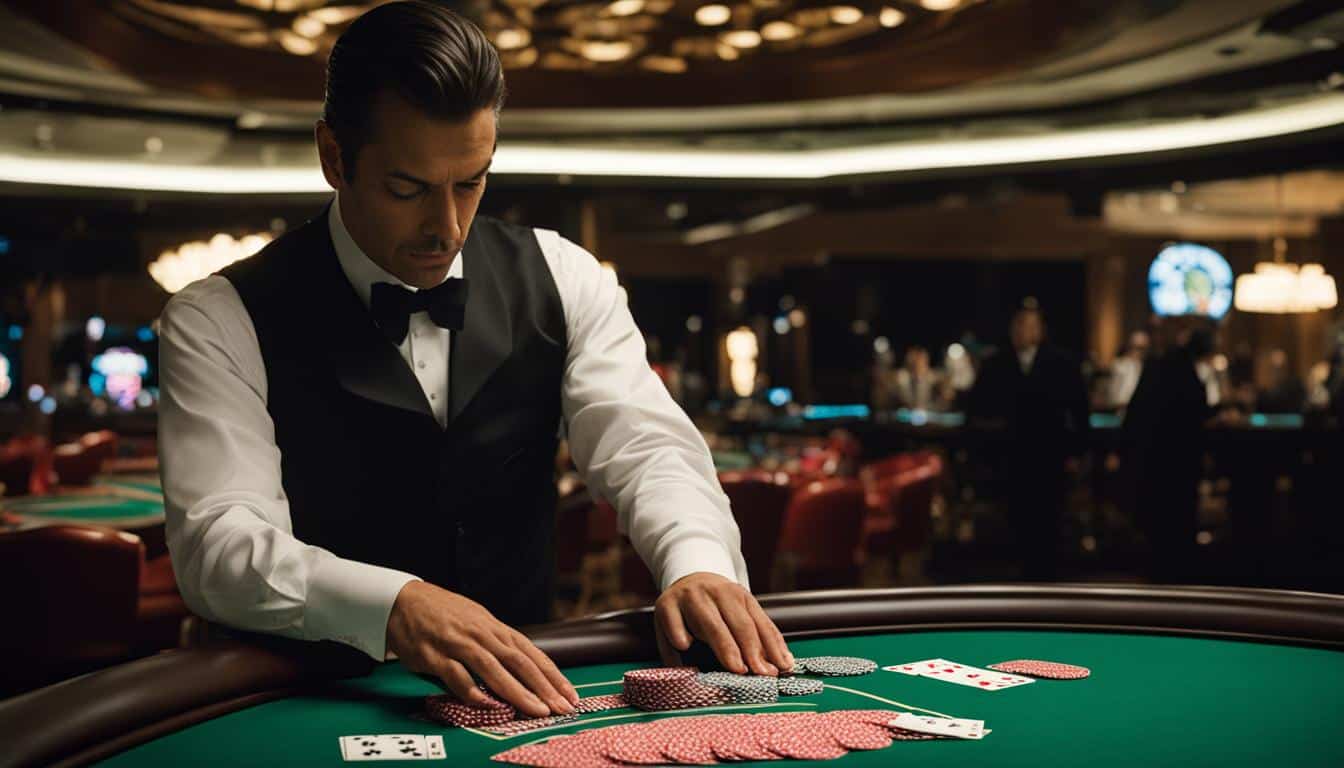Have you ever wondered how often blackjack dealers shuffle the cards during gameplay? Understanding the shuffle frequency is crucial for developing an effective strategy at the blackjack table. In this section, we will delve into the shuffle frequency and offer valuable insights into the game.
Knowing the rate at which dealers shuffle the decks will give you an advantage in the game. Keep reading to learn more about the importance of shuffling in blackjack, the factors that influence shuffle frequency, and effective strategies for capitalizing on shuffle frequency.
The keyword “how often do blackjack dealers shuffle” will play a crucial role throughout this article, as we explore the significance of shuffle frequency in blackjack gameplay.
The Importance of Shuffling in Blackjack
Shuffling is an integral part of the game of blackjack, and understanding the frequency at which dealers shuffle the cards can provide valuable insights into the game. A dealer’s shuffle rate can vary depending on various factors such as the policies of the casino, the number of players at the table, and other considerations.
The shuffling of cards is necessary to ensure fairness and prevent card counting by players. A dealer’s shuffle can significantly impact the outcome of each hand, making it an essential aspect to consider when playing blackjack.
Knowing the dealer’s shuffle rate can help players make informed decisions at the table, such as adjusting their betting strategy or deciding when to hit or stand. By understanding the relationship between shuffling and gameplay, players can improve their chances of success at the blackjack table.
Factors Influencing Shuffle Frequency
The frequency at which blackjack dealers shuffle the cards is not constant and can vary depending on several factors. Understanding these factors can help you anticipate when the shuffle will occur and adjust your gameplay strategy accordingly.
Number of Players at the Table
The number of players participating in a blackjack game can influence how often dealers shuffle the cards. In general, the more players there are at the table, the less frequently the cards will be shuffled. This is because the cards are more likely to be effectively randomized with a larger number of players and hands being dealt.
Casino Policies
Each casino has its own policies and procedures for blackjack games. Some casinos may require their dealers to shuffle the cards more frequently than others. This could be due to their desire to maintain a higher degree of randomness or to prevent card counting.
Other Factors Influencing Shuffle Intervals
Other factors that can influence shuffle intervals include the type of shuffle being used and the specific rules of the game being played. For example, games with more decks of cards may require more frequent shuffling to prevent the cards from becoming too predictable.

It’s important to keep in mind that while some of these factors may be predictable – such as the casino policies – others may be more difficult to anticipate. Ultimately, the shuffle frequency is ultimately at the discretion of the dealer.
By understanding the factors that influence the shuffle frequency, you can better anticipate when the shuffle will occur and adjust your playing strategy accordingly. In the next section, we will explore the common shuffle procedures used by blackjack dealers in casinos.
Common Shuffle Procedures in Casinos
When it comes to shuffling the cards in blackjack, casinos follow specific procedures designed to maintain fairness and prevent card manipulation. Let’s take a closer look at the most common shuffle techniques utilized by dealers in casinos.

The Riffle Shuffle
The riffle shuffle is a popular technique used to shuffle two decks of cards at once. The dealer divides the deck into two equal halves and bends each half slightly, allowing the cards to interlace with each other when shuffled back together. This technique is typically repeated several times to ensure randomness and impartiality.
The Strip Shuffle
The strip shuffle involves stripping small packets of cards from the top of the deck and shuffling them together while holding the remaining cards with the other hand. The shuffled packets are then combined with the rest of the deck, and the technique is repeated multiple times. This method is frequently used when dealing with a single deck of cards.
The Cut
After shuffling, the dealer must cut the deck to ensure that the cards are genuinely randomized. The dealer takes a chunk of cards from the middle of the deck and places it on top of the remaining deck. This technique ensures that no one knows the order of the cards beforehand and creates an additional layer of randomness in the game.
Understanding these common shuffle procedures gives players insights into the frequency at which dealers shuffle the decks. While casinos usually re-shuffle when approximately 75% of the cards have been dealt, this can vary depending on different factors. By paying attention to the shuffle procedure, players can adapt their strategies accordingly.
Card Counting and Shuffle Frequency
In the world of blackjack, card counting is a widely discussed and debated strategy. By keeping track of the cards that have already been played, players can gain insight into the remaining cards in the shoe, enabling them to make more informed decisions on future hands. However, card counting is not foolproof, as dealers are known to adjust their shuffle frequency in response to the actions of players. Let’s explore the complex relationship between card counting and shuffle frequency, and how it impacts the game of blackjack.
Card counters use a variety of techniques to track the remaining cards in the shoe. Some players use mental arithmetic to keep a running tally of high and low-value cards, while others may use more sophisticated methods such as computer simulations. Regardless of the method, card counters can gain valuable insights into the cards yet to be played, helping to inform their decision-making and potentially increase their odds of winning.
However, dealers are well aware of the prevalence of card counting in the game of blackjack and are trained to adjust their shuffle frequency in response to suspicious behavior. When dealers suspect that a player is counting cards, they may shuffle the decks more frequently to disrupt the count. Alternatively, when the count is in the player’s favor, they may decrease the shuffle frequency, preserving the player’s advantage.
Understanding the dynamic between card counting and shuffle frequency is essential for players looking to maximize their chances of winning at blackjack. While card counting can give players valuable insights into the remaining cards in the shoe, dealers are constantly adjusting shuffle frequency to thwart card counters. It’s a complex game of cat and mouse that requires players to make quick decisions and adapt to changing circumstances.
Strategies for Capitalizing on Shuffle Frequency
Knowing how often blackjack dealers mix the deck and how to adjust your game accordingly can give you a significant advantage at the table. Here are some effective strategies for capitalizing on shuffle frequency:
- Vary your betting: When dealers shuffle the deck more frequently, you should consider placing smaller bets to minimize your losses. Conversely, when shuffle frequency decreases, you can adjust your betting to maximize your returns.
- Count cards: By keeping track of the cards that have already been dealt, you can adjust your betting strategy and take advantage of the remaining cards in the deck.
- Adjust your playing strategy: When the deck is being reshuffled more frequently, you should consider playing a more conservative game, focusing on minimizing losses rather than maximizing gains.
- Switch tables: If you notice that a particular dealer is shuffling the deck too frequently, you can switch tables to find a game with more favorable shuffle intervals.
By incorporating these strategies into your gameplay, you can make the most of the shuffle frequency in blackjack and increase your chances of success.
A good website with promotions must be 89ufabet ทางเข้าเว็บตรง.
Conclusion
In conclusion, understanding the shuffle frequency in blackjack is crucial for developing an effective strategy. By taking into account the factors that influence shuffle intervals, players can adapt their approach to the game and increase their chances of success. Additionally, being aware of the different shuffle procedures and their impact on the game can give players a competitive edge.
Moreover, card counting is an essential skill for maximizing shuffle frequency dynamics. By keeping track of the remaining cards in the shoe, players can adjust their betting and playing strategies accordingly.
Finally, it is vital to remember that shuffle frequency can vary depending on the casino policies and the number of players at the table. Therefore, it is essential to pay attention to the dealer’s shuffle frequency and adjust your gameplay accordingly.
Overall, embracing the nuances of shuffle frequency in blackjack can enhance your experience and increase your chances of winning. By following the strategies outlined in this article, you can take advantage of the shuffle frequency dynamics and dominate the blackjack table.
FAQ
How often do blackjack dealers shuffle the cards?
The frequency at which blackjack dealers shuffle the cards can vary depending on several factors. Generally, dealers shuffle the cards after every round or hand. However, in some cases, they may continue dealing from the shoe without shuffling until a specific number of rounds or when the shoe reaches a certain point.
What is the importance of shuffling in blackjack?
Shuffling is a fundamental aspect of blackjack as it ensures randomization of the cards and prevents any biases or card tracking methods from being effective. Regular shuffling eliminates any predictability and keeps the game fair and unpredictable for all players.
What factors influence the shuffle frequency in blackjack?
The shuffle frequency is influenced by several factors, including the number of players at the table, casino policies, and specific game variations. More players at the table may result in more frequent shuffling, whereas fewer players can lead to longer intervals between shuffles. Casino policies and game variations may also dictate specific shuffle intervals.
How often do dealers shuffle cards in blackjack?
The frequency of card shuffling by dealers in blackjack can vary. It primarily depends on the number of rounds played or the amount of time that has passed since the last shuffle. Typically, dealers shuffle the cards after each completed round to maintain fairness and prevent any advantage play techniques.
How does card counting affect shuffle frequency in blackjack?
Card counting is a strategy used by some players to track the remaining cards in the shoe. When dealers observe card counting attempts, they may respond by increasing the shuffle frequency, making it harder for card counters to gain an advantage. Therefore, the presence of card counters can influence how often dealers shuffle the cards.
Are there any strategies to capitalize on shuffle frequency in blackjack?
Understanding the shuffle frequency can help players develop strategies to capitalize on the game’s dynamics. Adjusting betting and playing strategies based on the shuffle frequency can enhance one’s chances of making strategic decisions and potentially increasing their odds of winning. Adapting to the shuffle frequency is an important skill for every blackjack player.










